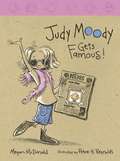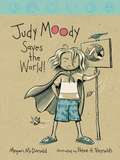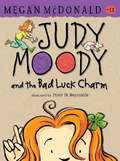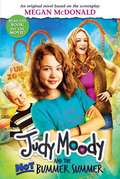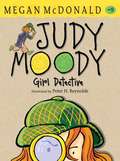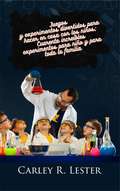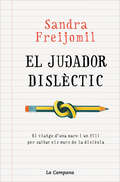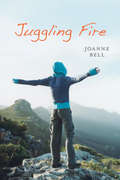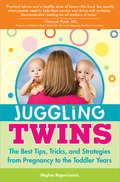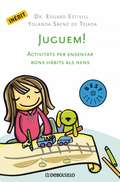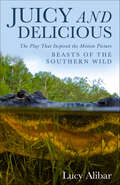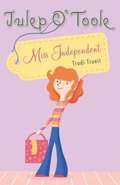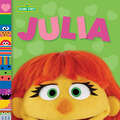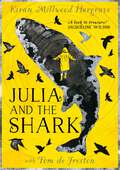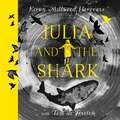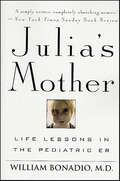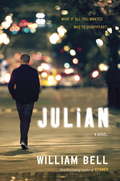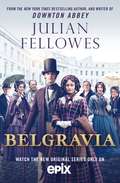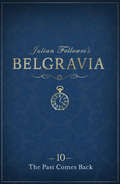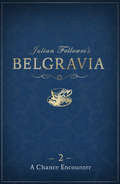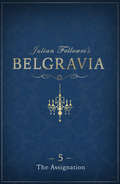- Table View
- List View
Judy Moody Gets Famous! (Judy Moody #2)
by Megan McdonaldGood moods, bad moods, can't-stand-Jessica-Finch moods. Judy Moody is back with her many hilarious moods. Fans of Judy Moody already know that Judy has a mood for every occasion--and this time Judy is in a jealous mood. Jealous of classmate Jessica Finch, that is, who gets her picture on the front page of the newspaper. When Judy sets off in pursuit of her own fame and happiness, watch out! She's so determined, she just might find it, or she might merely become more INFAMOUS than ever. Her latest adventures are sure to put readers in a very Judy Moody mood!
Judy Moody Saves the World! (Judy Moody #3)
by Megan McdonaldThe mercurial Judy returns - and she's in a mood to take on the world! Get ready for the newest installment in the hilarious Judy Moody series. Rare! Judy Moody did not set out to save the world. She set out to win a contest. A Band-Aid contest. It all started with the Crazy-Strip contest - and the dream that she, Judy Moody, might one day see her very own adhesive-bandage design covering the scraped knees of thousands. But when her "Heal the World" motif merits only an honorable mention, Judy Moody realizes it's time to set her sights on something bigger. Class 3T is studying the environment, and Judy is amazed to learn about the destruction of the rain forest, the endangered species (not) in her own backyard, and her own family's crummy recycling habits. Now she's in a mood to whip the planet into shape - or her name isn't Judy Monarch Moody!
Judy Moody and the Bad Luck Charm
by Megan Mcdonald Peter H. ReynoldsJudy has very good luck with a special penny, until her luck turns bad. The story involves her family and friends, a spelling bee and a potbellied pig named PeeGee WeeGee, or P.G. for short. The many illustrations are described. For middle elementary school readers. Note: this book does not use standard American spelling or punctuation.
Judy Moody and the NOT Bummer Summer
by Megan McdonaldJudy's big plans for the summer seem ruined when two of her best friends go away, and then her parents leave her and Stink with Aunt Opal, but a new "thrill-a-delic" plan has her racing toward fun.
Judy Moody, Girl Detective (Judy Moody #9)
by Megan McdonaldIt's an honest-to-jeepers mystery! Agent Judy Drewdy sets out to solve the case of the missing puppy when a canine-cop-in-training vanishes into thin air. Judy Moody is in a mood. A sleuthing, Nancy Drew kind of mood. So what's a WBMS (world's best mystery solver) to do? Go find a mystery, that's what! And she doesn't have to snoop for long: when Mr. Chips, a beloved crime-dog-in-training, goes missing, Judy Drewdy and her chums, agents Dills Pickle (Frank), Spuds Houdini (Rocky), and James Madagascar (Stink) find themselves smack-dab in the middle of a reallife, scare-your-pants-off whodunit. Was Mr. Chips stolen by dirty dognappers? And why are chocolate-chip cookies disappearing all over town? Watch out for red herrings--along with clever references to classic Nancy Drew mysteries--as Eagle Eye Moody and company are hot on the case!
Juegos y experimentos divertidos para hacer en casa con los niños: Cuarenta increíbles experimentos para niño y para toda la familia
by Carley R. LesterEste libro es una colección ideal de experimentos para familias, para iniciar a los niños al maravilloso mundo de la ciencia y la innovación tecnológica. Estas actividades pueden hacerse con cosas de la casa, lo que las vuelve mucho más faciles para los padres ocupados que quieren enseñarle a sus hijos lo basico en ciencia, ingeniería, arte y matemáticas a la vez que pasan un buen rato. En este excelente libro, Carley R. Lester une a las familias en el inmenso mundo de los experimentos, con actividades que le enseñan a los niños cómo funciona el mundo con explicaciones simples. Cada actividad está descrita con detalle, desde los materiales necesarios, los procedimientos y la explicación científica de lo que ocurre. Como padre, también estos experimentos fáciles te ayudarán a refrescar conocimientos científicos básicos. Explora estas divertidas actividades con tus hijos: •Construír un modelo de un átomo •Teñidos divertidos con leche •Construcción de un compás •Armar un geiser de Mentos en erupción •Cocinar critales de caramelo •Investigar las formas y los colores •Construir un puente de papel •Juegos con sombras •Creación de un aerodeslizador •Armar un imán •¡Y muchísimo más! "Juegos y experimentos divertidos para hacer en casa con los niños" es el libro perfecto para todos los padres que quieren pasar tiempo con sus hijos y que quieren que ellos se diviertan mientras aprenden. ¿Qué estás esperando? ¡Agrega este libro increíble a tu carrito!
Jugador dislèctic
by Sandra FreijomilUn llibre experiencial, sincer, sense edulcorants, emotiu i molt empàtic d'una mare que acompanya el seu fill a saltar junts els murs quasi infranquejables de la dislèxia, un trastorn que afecta entre el 4% i el 10% de la població. El jugador dislèctic no és un manual sobre la dislèxia. Tampoc no és un llibre d'autoajuda. No és un llibre dramàtic ni suavitzat amb floritures sobre aquesta discapacitat. El jugador dislèctic és un text que comparteix amb el lector què significa conviure amb la dislèxia des de la barrera d'algú que l'observa i empatitza -només com una mare o un pare ho pot fer-, amb el seu fill. Amb un EPÍLEG de l'actor Ivan Massagué, que ha conviscut tota la vida amb la dislèxia.
Juggling Fire
by Joanne BellSixteen-year-old Rachel embarks on a solo quest to find her father, who disappeared years ago in the Yukon wilderness.
Juggling Twins: The Best Tips, Tricks, and Strategies from Pregnancy to the Toddler Years
by Meghan Regan-LoomisFrom pregnancy to health issues, to eating, sleeping, bathing, and leaving the house, Juggling Twins is packed with the detailed, authoritative information that parents of multiples crave.
Juguem!
by Yolanda Sáenz de Tejada Eduardo EstivillGuia per comprar aquest llibre: Obre aquest llibre sempre que pensis que els nens són nens, que depenen de la teva alegria i que creixen amb els teus petons. Si no ho creus així, no malgastis els diners, pots fullejar-lo i tornar-lo a la prestatgeria. O regalar-lo a algú que vulgui viure novament al cor dels nens. De vegades els bons hàbits en lalimentació, en la higiene o en el comportament són difícils dinculcar. Aquest llibre pretén que els pares, per mitjà duns jocs divertits, eduquin els fills a la vegada que creixen amb ells.
Juicy and Delicious: The Play That Inspired the Motion Picture Beasts of the Southern Wild
by Lucy AlibarLucy Alibar is a screenwriter, playwright and storyteller from the Florida panhandle. Her film, Beasts of the Southern Wild, which she wrote with Behn Zeitlin, and is based on her original play, Juicy and Delicious, won the Narrative Grand Jury Prize at this year&’s Sundance Film Festival. Fox Searchlight will be releasing the film this summer. Her other plays include, A Friend of Dorothy(Best Play Finalist, Montreal Fringe), Lightning/Picnic (Ensemble Studio Theatre), Mommy Says I&’m Pretty on the Insides (Williamstown Theatre Festival), and Christmas and Jubilee Behold the Meteor Shower (New Georges).Her work has been produced and developed at the Sundance Institute, Joe&’s Pub, Williamstown Theatre Festival, HERE Arts Center, Ensemble Studio Theatre, Dixon Place, New Georges, Edinburgh Fringe, the Avignon Festival, and the Cherry Lane Theatre. Lucy is a member of Court 13, EST/Youngblood, Jose Rivera&’s Writing Group, and founder of the New Georges Writer/Director Lab. She is a Sundance Screenwriting Fellow, two-time finalist for the Heideman Award at Actor&’s Theatre of Louisville, and winner of Young Playwrights, Inc. She bakes a mean coconut cake.
Julep O'Toole: Miss Independent
by Trudi TrueitJulep O'Toole feels grown up. She's eleven, after all, and ready to be independent! Now she just has to convince her mom that she's old enough to wear makeup, have a cell phone, choose her own clothes, and make decisions about everything else in her life. After all, her mom lets Julep's older sister, Harmony, do all these things. but just when Julep thinks her mom is finally starting to listen to her, a disastrous shopping trip stops everything. Now Julep and her mom are not even speaking! Will Julep ever be understood and finally have the chance to be herself?
Julia (Sesame Street Friends)
by Andrea Posner-SanchezMeet your favorite Sesame Street friends in this adorable photographic board book starring Julia, a muppet with autism!Elmo's friend Julia is the star of this colorful, photographic board book. Babies and toddlers will love turning the sturdy pages to find out what Julia--a muppet with autism--likes to do with her family, her puppy, and her Sesame Street friends. Look for all the Sesame Street Friends books:ELMO ABBY BIG BIRD COOKIE GROVER OSCARTHE COUNT BERT & ERNIESesame Workshop, the nonprofit educational organization behind Sesame Street, aims to help kids grow smarter, stronger, and kinder through its many unique domestic and international initiatives. These projects cover a wide array of topics for families around the world.
Julia and the Shark
by Kiran Millwood HargraveA captivating, powerful and luminous story from a bestselling, award-winning author about a mother, a daughter, and the great Greenland shark. With mesmerising black and yellow illustrations and presented as a deluxe hardback with tracing paper inserts, this is a perfect gift for 9+ fans of David Almond and Frances Hardinge.'Tom de Freston's stunning illustrations perfectly complement the poetry of Kiran Millwood Hargrave's story' Cressida Cowell'A truly beautiful book, with text and illustrations in perfect harmony. A book to treasure!' Jacqueline Wilson'Julia and the Shark is deep, beautiful and true. The art shines and the writing soars - a classic from cover to cover' Eoin Colfer'A rich, immersive and wondrous journey, through deep darkness to hope and light' Sophie Anderson, author of The House with Chicken LegsThe shark was beneath my bed, growing large as the room, large as the lighthouse, rising from unfathomable depths until it ripped the whole island from its roots. The bed was a boat, the shark a tide, and it pulled me so far out to sea I was only a speck, a spot, a mote, a dying star in an unending sky...Julia has followed her mum and dad to live on a remote island for the summer - her dad, for work; her mother, on a determined mission to find the elusive Greenland shark. But when her mother's obsession threatens to submerge them all, Julia finds herself on an adventure with dark depths and a lighthouse full of hope...A beautiful, lyrical, uplifting story about a mother, a daughter, and love - with timely themes of the importance of science and the environment.
Julia and the Shark
by Kiran Millwood HargraveA captivating, powerful and luminous story from a bestselling, award-winning author about a mother, a daughter, and the great Greenland shark. Narrated beautifully with atmospheric sound effects, this is a perfect audiobook for 9+ fans of David Almond and Frances Hardinge.'A truly beautiful book, with text and illustrations in perfect harmony. A book to treasure!' Jacqueline Wilson'Julia and the Shark is deep, beautiful and true. The art shines and the writing soars - a classic from cover to cover' Eoin Colfer'A rich, immersive and wondrous journey, through deep darkness to hope and light' Sophie Anderson, author of The House with Chicken LegsThe shark was beneath my bed, growing large as the room, large as the lighthouse, rising from unfathomable depths until it ripped the whole island from its roots. The bed was a boat, the shark a tide, and it pulled me so far out to sea I was only a speck, a spot, a mote, a dying star in an unending sky...Julia has followed her mum and dad to live on a remote island for the summer - her dad, for work; her mother, on a determined mission to find the elusive Greenland shark. But when her mother's obsession threatens to submerge them all, Julia finds herself on an adventure with dark depths and a lighthouse full of hope...A beautiful, lyrical, uplifting story about a mother, a daughter, and love - with timely themes of the importance of science and the environment.(P) 2021 Hodder & Stoughton Limited
Julia's Daughters
by Colleen FaulknerJulia Maxton can't imagine anything worse than losing one of her three daughters--until the day seventeen-year-old Haley runs a stop sign, killing her younger sister Caitlin. Six weeks after the crash, the family is falling apart. Julia struggles not to show hostility toward Haley, but her deep-rooted anger won't go away. Her husband, Ben, has drifted away emotionally. Their youngest daughter, Izzy, is lost in the shuffle. And despite Haley's insistence that she's fine, her actions scream otherwise. Fearing that she's about to lose a second child, Julia decides to take Haley on a cross-country drive. Maybe somewhere between Nevada and Maine they can bridge the gulf between them. But first there will be painful questions to face--is Julia a good mother? Did she secretly love responsible, respectful Caitlin more than defiant Haley? Can Haley ever find peace with her mother--and herself--again? In Colleen Faulkner's most thought-provoking and complex novel to date, an unthinkable tragedy becomes the starting place for a powerful journey toward healing and hope. Honest and unforgettable, Julia's Daughters explores the surprising ways that families--even the most fractured--can save each other, over and over again.
Julia's Mother: Life Lessons in the Pediatric ER
by William BonadioA real-life pediatric emergency room doctor reveals the trials, heartbreaks, and triumphs of his work.It's a place of intense human drama, life's highest hopes and deepest despairs. A place we rarely get to see through a doctor's eyes.But now the emergency room at a children's hospita is revealed in a moving and personal notembook by William Bondio, MD. It recounts the lessons a doctor learns beyond the textbooks, revealing insights into the human condition at its most vulnerable and courageous moments--from the patient who, after intense medical therapy, gives up the will to live, to the sick newborn baby who never would. We feel the power of a mother's instinct to advocate for her handicapped child, and observe the wisdom of an immigrant father who intuitively senses things the doctors cannot. Finally, with the mother of a young patient named Julia we share in the nobility of a parent's unending search to find meaning in tragedy.
Julian
by William BellAn unusual mystery, a heartrending love story, this is an exciting plot-driven new book from leading Canadian YA author William Bell. Fifteen-year-old Aidan has had more foster parents than he cares to remember. Careful to always keep his distance from those around him, and aided by a deep well of self-reliance and tenacity, he longs for the day that he's old enough to strike out on his own. That day comes sooner than he could ever have imagined. On a miserable March afternoon, Aidan's life is changed so radically as to become unrecognizable. Through a near-tragic event in which he saves the life of a young boy, Aidan earns the gratitude and unqualified support of the child's grandfather, Mr. Bai, a man of wealth, great resources and shadowy influence. When asked how this man can help repay him, Aidan replies, "Can you make me disappear?" With a new identity, an apartment, a job and finally a sense that he's crafting his own destiny, Aidan--now Julian Paladin--finds himself at the centre of forces he can't begin to understand. Who exactly is Mr Bai and who are the mysterious women that come and go without a trace in the apartment below? How did Julian find himself taking on a job surveilling a university student and her possibly abusive boyfriend? And, the most potent mystery of all: how can he ever be without the bewitching and beautiful Ninon, who reveals a dimension of life Julian had never thought possible. Julian is part detective story, part romance, and part quest for a life of independence and meaning.
Julian Fellowes's Belgravia (Julian Fellowes's Belgravia)
by Julian FellowesJulian Fellowes's Belgravia is the story of a secret. A secret that unravels behind the porticoed doors of London's grandest postcode. Set in the 1840s when the upper echelons of society began to rub shoulders with the emerging industrial nouveau riche, Belgravia is people by a rich cast of characters. But the story begins on the eve of the Battle of Waterloo in 1815. At the Duchess of Richmond's n0w legendary ball, one family's life will change forever. Facebook: JulianFellowesBelgravia Twitter: @JFBelgravia Pinterest: /Belgravia Instagram: @julianfellowesbelgravia
Julian Fellowes's Belgravia Episode 10: The Past Comes Back (Julian Fellowes's Belgravia #10)
by Julian FellowesThe full truth of what happened that night at the Duchess of Richmond's ball is revealed.Julian Fellowes's Belgravia is a story in 11 episodes published week by week in the tradition of Charles Dickens.Belgravia is the story of a secret. A secret that unravels behind the porticoed doors of London's grandest postcode. The story behind the secret will be revealed in weekly bite-sized installments complete with twists and turns and cliff-hanger endings.Set in the 1840s when the upper echelons of society began to rub shoulders with the emerging industrial nouveau riche, Belgravia is peopled by a rich cast of characters. But the story begins on the eve of the Battle of Waterloo in 1815. At the Duchess of Richmond's now legendary ball, one family's life will change forever...Facebook: JulianFellowesBelgraviaTwitter: @JFBelgraviaPinterest: /BelgraviaInstagram: @julianfellowesbelgravia
Julian Fellowes's Belgravia Episode 1: Dancing into Battle
by Julian FellowesREAD THIS PART IN THIS 11-PART SERIES FREE! On the eve of the Battle of Waterloo, two families meet at the Duchess of Richmond's Ball. From this moment on, their stories will be linked by a secret.Julian Fellowes's Belgravia is a story in 11 episodes published week by week in the tradition of Charles Dickens.Belgravia is the story of a secret. A secret that unravels behind the porticoed doors of London's grandest postcode. The story behind the secret will be revealed in weekly bite-sized instalments complete with twists and turns and cliff-hanger endings.Set in the 1840s when the upper echelons of society began to rub shoulders with the emerging industrial nouveau riche, Belgravia is peopled by a rich cast of characters. But the story begins on the eve of the Battle of Waterloo in 1815. At the Duchess of Richmond's now legendary ball, one family's life will change forever...Facebook: JulianFellowesBelgraviaTwitter: @JFBelgraviaPinterest: /BelgraviaInstagram: @julianfellowesbelgravia
Julian Fellowes's Belgravia Episode 2: A Chance Encounter (Julian Fellowes's Belgravia #2)
by Julian FellowesAn invitation to afternoon tea results in some startling revelations.Julian Fellowes's Belgravia is a story in 11 episodes published week by week in the tradition of Charles Dickens.Belgravia is the story of a secret. A secret that unravels behind the porticoed doors of London's grandest postcode. The story behind the secret will be revealed in weekly bite-sized installments complete with twists and turns and cliff-hanger endings.Set in the 1840s when the upper echelons of society began to rub shoulders with the emerging industrial nouveau riche, Belgravia is peopled by a rich cast of characters. But the story begins on the eve of the Battle of Waterloo in 1815. At the Duchess of Richmond's now legendary ball, one family's life will change forever...
Julian Fellowes's Belgravia Episode 4: At Home in Belgrave Square (Julian Fellowes's Belgravia #4)
by Julian FellowesA dashing young man appears at Lady Brockenhurst's soiree - but who is he and why is he so favored by their hostess?Julian Fellowes's Belgravia is a story in 11 episodes published week by week in the tradition of Charles Dickens.Belgravia is the story of a secret. A secret that unravels behind the porticoed doors of London's grandest postcode. The story behind the secret will be revealed in weekly bite-sized installments complete with twists and turns and cliff-hanger endings.Set in the 1840s when the upper echelons of society began to rub shoulders with the emerging industrial nouveau riche, Belgravia is peopled by a rich cast of characters. But the story begins on the eve of the Battle of Waterloo in 1815. At the Duchess of Richmond's now legendary ball, one family's life will change forever...
Julian Fellowes's Belgravia Episode 5: The Assignation (Julian Fellowes's Belgravia #5)
by Julian FellowesThe gambling dens of London and a secret assignation provide the backdrop for indiscretions large and small.Julian Fellowes's Belgravia is a story in 11 episodes published week by week in the tradition of Charles Dickens.Belgravia is the story of a secret. A secret that unravels behind the porticoed doors of London's grandest postcode. The story behind the secret will be revealed in weekly bite-sized installments complete with twists and turns and cliff-hanger endings.Set in the 1840s when the upper echelons of society began to rub shoulders with the emerging industrial nouveau riche, Belgravia is peopled by a rich cast of characters. But the story begins on the eve of the Battle of Waterloo in 1815. At the Duchess of Richmond's now legendary ball, one family's life will change forever...Facebook: JulianFellowesBelgraviaTwitter: @JFBelgraviaPinterest: /BelgraviaInstagram: @julianfellowesbelgravia
Julian Fellowes's Belgravia Episode 7: A Man of Business (Julian Fellowes's Belgravia #7)
by Julian FellowesA spurned son plots his revenge. Julian Fellowes's Belgravia is a story in 11 episodes published week by week in the tradition of Charles Dickens. Belgravia is the story of a secret. A secret that unravels behind the porticoed doors of London's grandest postcode. The story behind the secret will be revealed in weekly bite-sized installments complete with twists and turns and cliff-hanger endings.Set in the 1840s when the upper echelons of society began to rub shoulders with the emerging industrial nouveau riche, Belgravia is peopled by a rich cast of characters. But the story begins on the eve of the Battle of Waterloo in 1815. At the Duchess of Richmond's now legendary ball, one family's life will change forever...Facebook: JulianFellowesBelgraviaTwitter: @JFBelgraviaPinterest: /BelgraviaInstagram: @julianfellowesbelgravia
